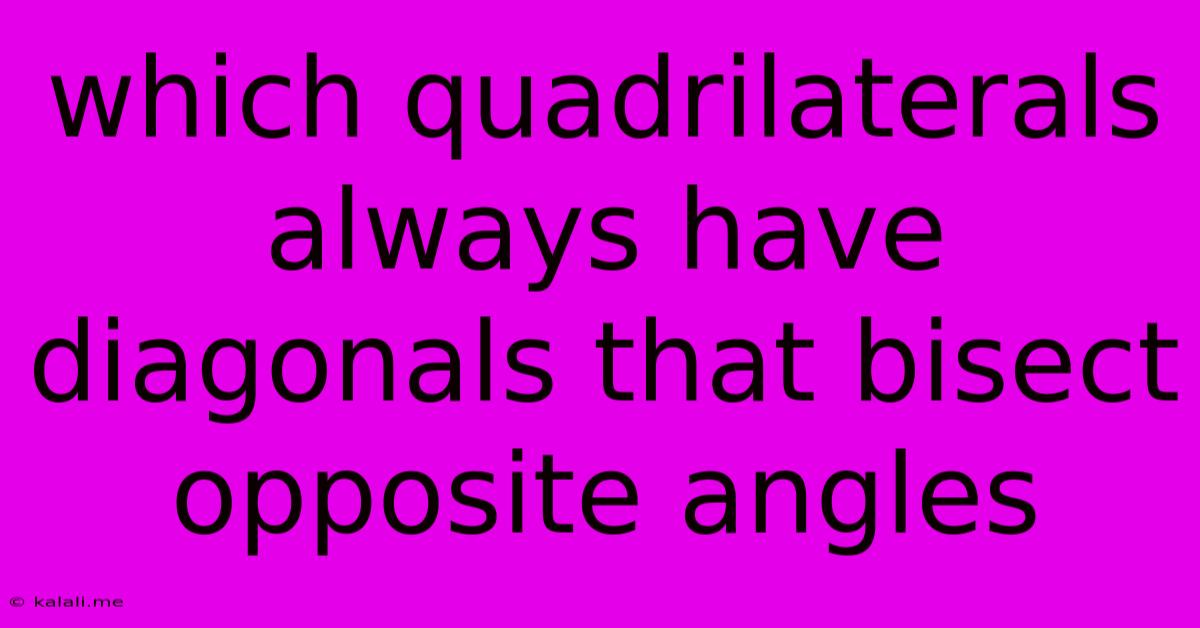Which Quadrilaterals Always Have Diagonals That Bisect Opposite Angles
Kalali
May 09, 2025 · 3 min read

Table of Contents
Which Quadrilaterals Always Have Diagonals That Bisect Opposite Angles?
Meta Description: Discover which quadrilaterals guarantee their diagonals bisect opposite angles. We explore the properties of rhombuses, squares, and other shapes, clarifying the relationship between diagonals and angle bisection. Learn how these geometric properties impact various applications.
Quadrilaterals, four-sided polygons, exhibit diverse properties depending on their specific characteristics. One interesting property to investigate is whether the diagonals bisect opposite angles. Not all quadrilaterals share this trait; in fact, it's a defining characteristic of only certain types. Let's delve into which quadrilaterals consistently demonstrate this unique geometric feature.
Understanding Diagonal Bisection
Before we identify the quadrilaterals, let's define what it means for a diagonal to bisect opposite angles. A diagonal of a quadrilateral is a line segment connecting two non-adjacent vertices. If a diagonal bisects opposite angles, it divides those angles into two equal angles. This means the angle created on one side of the diagonal is congruent to the angle on the other side. This property isn't arbitrary; it's directly linked to the internal symmetries of the quadrilateral.
Rhombuses: A Key Example
A rhombus is a quadrilateral where all four sides are of equal length. Crucially, the diagonals of a rhombus always bisect the opposite angles. This is a direct consequence of the rhombus's inherent symmetry. Because all sides are equal, the diagonals create congruent triangles, leading to the bisection of opposite angles. Consider the triangles formed by one diagonal; they're congruent by the Side-Side-Side (SSS) postulate, resulting in the equality of the angles.
Squares: A Special Case
A square, being a special type of rhombus (and also a rectangle), naturally inherits this property. Since a square is a rhombus with right angles, its diagonals not only bisect the opposite angles but also intersect at right angles themselves. This added property makes the square's symmetry even more pronounced.
Other Quadrilaterals
It's important to note that while rhombuses and squares possess this property, other quadrilaterals do not. Rectangles (excluding squares) and parallelograms (excluding rhombuses and squares) generally do not have diagonals that bisect opposite angles. Their diagonals might bisect each other, but they won't necessarily bisect the angles. This difference highlights the importance of the equal side length condition in rhombuses.
Kite Quadrilaterals: A Partial Exception
Kites present a slight exception. A kite is a quadrilateral with two pairs of adjacent sides that are equal in length. One of its diagonals bisects a pair of opposite angles; however, it's not a guarantee for both pairs of opposite angles. This makes it a partial exception to the rule.
Conclusion: Diagonals and Angle Bisection
In conclusion, the quadrilaterals whose diagonals always bisect opposite angles are rhombuses and their special case, the square. While kites offer a partial fulfillment of this property, it's only the rhombus and its derivatives that consistently exhibit this unique geometrical characteristic. Understanding this distinction provides a deeper appreciation for the interplay between a quadrilateral's shape and its properties. This understanding has practical applications in various fields, including engineering, architecture, and computer graphics.
Latest Posts
Latest Posts
-
Lowest Common Multiple Of 12 And 30
May 10, 2025
-
Cuantos Mililitros Es Un Litro De Agua
May 10, 2025
-
How Many Cms Is 3 Inches
May 10, 2025
-
How Much Is 3 4 Of A Pint
May 10, 2025
-
How To Find Limits Of Rational Functions
May 10, 2025
Related Post
Thank you for visiting our website which covers about Which Quadrilaterals Always Have Diagonals That Bisect Opposite Angles . We hope the information provided has been useful to you. Feel free to contact us if you have any questions or need further assistance. See you next time and don't miss to bookmark.